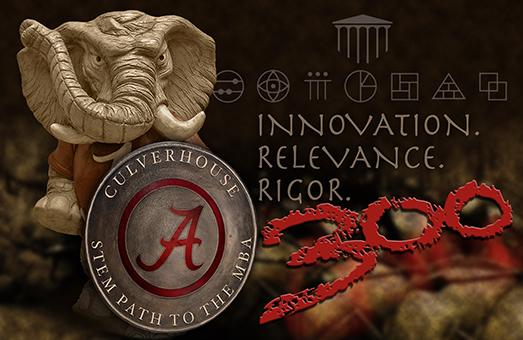Students with a clear focus on their learning path now have the chance to finish both their undergraduate and master’s degrees in less than the traditional six years through the science, technology, engineering and mathematics path to the MBA in the Capstone’s Culverhouse College of Commerce.
Created by Rob Morgan and Michael Hardin, the STEM path is designed to give students majoring in science, technology, engineering or mathematics the option of completing their MBA in just one year of graduate study by utilizing nontraditional educational methods.
“We recruit high-performing high school seniors who have gotten a 28 or above on the ACT, have a 3.5 GPA or above and are planning on majoring in a STEM discipline,” ?Morgan said.
This is the fourth year that the STEM program has been available at the University, which means the first class of students in the program is finishing up their undergraduate study and is now preparing for their final year before receiving their MBA. Eighty to 85 percent of current STEM students are majoring in engineering, ?Morgan said.
Students who are accepted into the STEM to MBA program take a business honors course every year of their undergraduate study. During their junior year, they apply to the University’s MBA program. Once admitted, they begin taking MBA courses.
“STEM to MBA is a great option for higher education, because I can get my MBA in one additional year versus the traditional two years,” said Gretchen Landego, a sophomore majoring in mechanical engineering. “STEM to MBA is different from traditional higher education paths, because everyone in it is majoring in a math or science field, and the classes we take now count as grad school credits.”
Additionally, students participating in the STEM to MBA program have opportunities to further their career options outside of the classroom, which helps to prepare them for a life after graduation.
“STEM is not simply a classroom and degree opportunity,” said Thomas Wesley, a sophomore majoring in computer science.“It presents a plethora of job opportunities, guest speakers and mentoring from top notch professors. On any given day, you can receive an email with some sort of event to improve your professional standing.”
The success of the program is evident, Morgan said. When the program was introduced to the University four years ago, there were only 64 students enrolled. This year, the STEM to MBA program received 420 applications and has 300 accepted students.
“We have a corporate advisory board with 15 companies, and all of them say that these students are exactly the kind of people that they want to hire,” Morgan said.
He added that the first group of students who are involved in the STEM program have seen a 30-point increase on GMAT scores over students who are following a traditional higher education track.
“Hardin’s vision for the program and how it would integrate into the business school is the vision we’ve been going on. It’s been a tremendous success,” he said.







